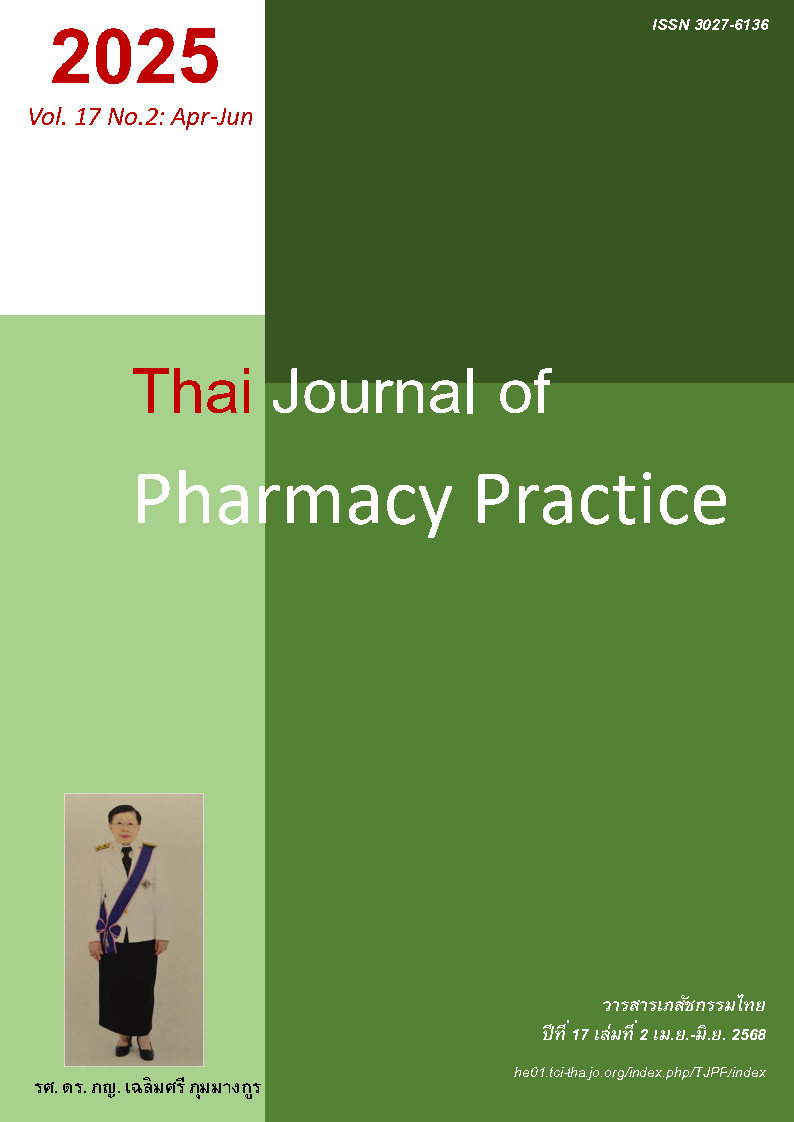Mechanisms for Network Operation and Community Participation for the Surveillance System of Drugs and Health Products in Communities: Case Study of Phayao, Chiang Rai, and Chiang Mai
Main Article Content
Abstract
Objective: To analyze the mechanisms of network operation and community participation in the pharmacovigilance system for drugs and health products in the communities within Phayao, Chiang Rai, and Chiang Mai. Methods: This qualitative research collected data through in-depth interviews using a semi-structured questionnaire. The study selected informants by purposive sampling and snowball sampling. Forty-four informants included pharmacists from provincial health offices, hospital pharmacists, district health officers, sub-district health promoting hospital officers, members of the District Health Board (DHB), representatives of provincial consumer council, business owners, village health volunteers, and community members. Results: The key mechanisms in the network operation include: 1) Diversity of network members from various sectors who were core members of the local networks; 2) Competent coordinators at all levels who had well-established relationships within the communities; 3) Adequate supports for budget, materials, and equipment for conducting community activities; 4) Systematic management through DHB committees, or local community agreements; 5) Rapid communication within the network with convenient and fast channels appropriate to activities with prompt responses from network leaders and coordinators; and 6) Having a public sector network working together at any level. Key mechanisms to promote community participation include: 1) Raising awareness of the problems by feeding the evidence of health problems and impacts back the communities; 2) Organizing a variety of activities to stimulate continuous participation among network members; and 3) Emphasizing the value of members through praise, recognition, and acceptance. Conclusion: The network operational and community participation mechanisms found in the study contribute to the strength and efficiency of the community-based pharmacovigilance system for drugs and health products.
Article Details

This work is licensed under a Creative Commons Attribution-NonCommercial-NoDerivatives 4.0 International License.
ผลการวิจัยและความคิดเห็นที่ปรากฏในบทความถือเป็นความคิดเห็นและอยู่ในความรับผิดชอบของผู้นิพนธ์ มิใช่ความเห็นหรือความรับผิดชอบของกองบรรณาธิการ หรือคณะเภสัชศาสตร์ มหาวิทยาลัยสงขลานครินทร์ ทั้งนี้ไม่รวมความผิดพลาดอันเกิดจากการพิมพ์ บทความที่ได้รับการเผยแพร่โดยวารสารเภสัชกรรมไทยถือเป็นสิทธิ์ของวารสารฯ
References
Sukamolson S, Sriviriyanuparp W, Kulsomboon V. Priority, Prevalence and geographic distribution of unsafe products in Thailand. Journal of Health Systems Research 2016; 10: 65-79.
Phetcharaburanin P, Saokaew S. Prevalence of unsafe medicines in groceries: a case study in the districts of Lom Kao, Khao Kho and Nam Nao in Phetchabun Province. Thai Journal of Pharmacy Practice 2019; 11: 422–30.
Ruenruay S, Saokaew S. Situation of medicines and dietary supplements in the Health Provider Board Region 3. Thai Journal of Pharmacy Practice 2017; 9: 225-35.
Boonyoung U, Muenpa R. Prevalence of and factors affecting inappropriate sale of drugs in grocery stores within Phitsanulok Province. Thai Journal of Pharmacy Practice 2019; 11: 105-18.
Booddawong B, Kiatying-Angsulee N, Wanleepong K, Boonmanus L, Kadsomboon O, Dokbua J, et al. Sources and distribution of unlawful medicines in 8 Provinces of Thailand: to Inform the public policy change. Isan Journal of Pharmaceutical Sciences 2016; 11 Suppl: S260-8
Surin N. Prevalence and characteristics of grocery stores that sold antibiotics in Amphoe Muangpan, Lampang province. Thai Journal of Pharmacy Practice 2015; 7: 200-5.
Wiriyanutai P. Prevalence and characteristics of groceries that provided antibiotics in Ngao District, Lampang Province. Thai Journal of Pharmacy Practice 2015; 7: 167-77.
Koonyodying A. Prevalence and characteristics of antibiotics providing groceries in Amphoe Wangnuea, Lampang province. Thai Journal of Pharmacy Practice 2015; 7: 114-20.
Sungthong W. Prevalence of grocery stores with antibiotics selling at Maesuai district, Chiang Rai Province and its affecting factors. Thai Journal of Pharmacy Practice 2015; 7: 38-46.
Saramon P, Ruengorn C, Seangphichai S, Wonghankla B. Epidemic of inappropriate health products and associated adverse events among chronic disease patients in border area, Wieng Kan District, Chiang Rai Province. Thai Journal of Pharmacy Practice 2019; 11: 307-17.
Panya R. Effects of the intervention on steroid adulterated health products at the communities in the catchment area of Khun Lan Sub-district Health Promoting Hospital, Dok Kham Tai District, Phayao. Thai Journal of Pharmacy Practice 2019; 11: 552-63.
Suntep W. Lesson learned from the consumer protection operated by the Network of Bawal-Ral (home, temple, school and hospital), Lampang Province. Journal of Health Sciences Scholarship 2018; 6: 16-30.
Office of the National Health Commission. Resolution 12.4 Community-centered system management for becoming a rational drug use country [online]. 2019 [cited Mar 31, 2024]. Available from: www.samatcha.org/site/resolution/d5550140-ac9b-40ef-a382-ae0da254c85f/detail
Nata P, Suwannaprom P, Awiphan R. Integrating pharmacist’s roles in health consumer protection into community health system. Thai Journal of Pharmacy Practice 2017; 11: 61-76.
Netchanok K, Rungreangkulkij S, Kotnara I. Integrating operations to develop of a mechanism to coordinate and prevent the problem of teenage pregnancy: a case study in Chaiyaphum Province. Journal of Health Science 2020; 29: 191-200.
Booddawong B, Yoongthong W. Community empowerment in the management of the problems on Inappropriate drugs and health products: case study of Nonkhun District, Sisaket Province. Thai Journal of Pharmacy Practice 2016; 8: 331-43.
Division of Health Education, Department of Health Promotion. Networking and community engagement in health behavior change in communities. Nonthaburi: Ministry of Public Health; 2013.
Angkanavisul T, Musikachai P. Lessons learned from the project on drug safety management within community by engaging the network of partners in Phra Nakhon Si Ayutthaya during 2015-2017. Thai Journal of Pharmacy Practice 2018; 10: 142-60.

